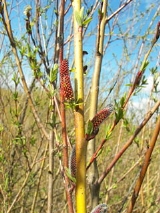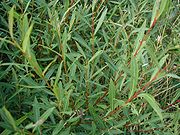
Purple Willow
Encyclopedia
Salix purpurea is a species of willow
native to most of Europe
and western Asia
north to the British Isles
, Poland
, and the Baltic States
.
 It is a deciduous
It is a deciduous
shrub
growing to 1-3 m (rarely to 5 m) tall, with purple-brown to yellow-brown shoots, turning pale grey on old stems. The leaves
are 2-8 cm (rarely to 12 cm) long and 0.3-1 cm (rarely 2 cm) wide; they are dark green above, glaucous green below, and unusually for a willow, are often arranged in opposite pairs rather than alternate. The flower
s are small catkin
s 1.5-4.5 cm long, produced in early spring; they are often purple or red in colour, whence the name of the species (other willows mostly have whitish, yellow or green catkins).
Use - The wood of this type of species is used in making cricket bat.
It is replaced further east in Asia by the closely related species Salix sinopurpurea (syn. S. purpurea var. longipetiolatea).
As with several other willows, the shoots, called withies
, are often used in basket
ry.
Willow
Willows, sallows, and osiers form the genus Salix, around 400 species of deciduous trees and shrubs, found primarily on moist soils in cold and temperate regions of the Northern Hemisphere...
native to most of Europe
Europe
Europe is, by convention, one of the world's seven continents. Comprising the westernmost peninsula of Eurasia, Europe is generally 'divided' from Asia to its east by the watershed divides of the Ural and Caucasus Mountains, the Ural River, the Caspian and Black Seas, and the waterways connecting...
and western Asia
Asia
Asia is the world's largest and most populous continent, located primarily in the eastern and northern hemispheres. It covers 8.7% of the Earth's total surface area and with approximately 3.879 billion people, it hosts 60% of the world's current human population...
north to the British Isles
British Isles
The British Isles are a group of islands off the northwest coast of continental Europe that include the islands of Great Britain and Ireland and over six thousand smaller isles. There are two sovereign states located on the islands: the United Kingdom of Great Britain and Northern Ireland and...
, Poland
Poland
Poland , officially the Republic of Poland , is a country in Central Europe bordered by Germany to the west; the Czech Republic and Slovakia to the south; Ukraine, Belarus and Lithuania to the east; and the Baltic Sea and Kaliningrad Oblast, a Russian exclave, to the north...
, and the Baltic States
Baltic states
The term Baltic states refers to the Baltic territories which gained independence from the Russian Empire in the wake of World War I: primarily the contiguous trio of Estonia, Latvia, Lithuania ; Finland also fell within the scope of the term after initially gaining independence in the 1920s.The...
.

Deciduous
Deciduous means "falling off at maturity" or "tending to fall off", and is typically used in reference to trees or shrubs that lose their leaves seasonally, and to the shedding of other plant structures such as petals after flowering or fruit when ripe...
shrub
Shrub
A shrub or bush is distinguished from a tree by its multiple stems and shorter height, usually under 5–6 m tall. A large number of plants may become either shrubs or trees, depending on the growing conditions they experience...
growing to 1-3 m (rarely to 5 m) tall, with purple-brown to yellow-brown shoots, turning pale grey on old stems. The leaves
Leaf
A leaf is an organ of a vascular plant, as defined in botanical terms, and in particular in plant morphology. Foliage is a mass noun that refers to leaves as a feature of plants....
are 2-8 cm (rarely to 12 cm) long and 0.3-1 cm (rarely 2 cm) wide; they are dark green above, glaucous green below, and unusually for a willow, are often arranged in opposite pairs rather than alternate. The flower
Flower
A flower, sometimes known as a bloom or blossom, is the reproductive structure found in flowering plants . The biological function of a flower is to effect reproduction, usually by providing a mechanism for the union of sperm with eggs...
s are small catkin
Catkin
A catkin or ament is a slim, cylindrical flower cluster, with inconspicuous or no petals, usually wind-pollinated but sometimes insect pollinated . They contain many, usually unisexual flowers, arranged closely along a central stem which is often drooping...
s 1.5-4.5 cm long, produced in early spring; they are often purple or red in colour, whence the name of the species (other willows mostly have whitish, yellow or green catkins).
Use - The wood of this type of species is used in making cricket bat.
It is replaced further east in Asia by the closely related species Salix sinopurpurea (syn. S. purpurea var. longipetiolatea).
As with several other willows, the shoots, called withies
Withy
Withy or withe is a strong flexible willow stem that is typically used in thatching and for gardening. An advantage of using this type of material is said to be a greater resistance to woodworm....
, are often used in basket
Basket
A basket is a container which is traditionally constructed from stiff fibres, which can be made from a range of materials, including wood splints, runners, and cane. While most baskets are made from plant materials, other materials such as horsehair, baleen, or metal wire can be used. Baskets are...
ry.

